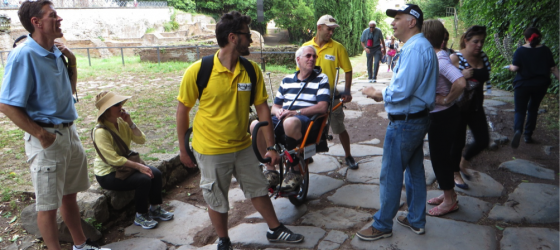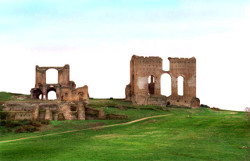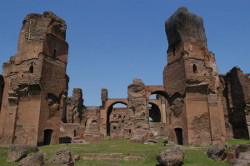Destination Search
-
The UK's largest accessible holiday specialist
-
Guaranteed accessible accommodation
-
Many properties personally audited
-
Flights, adapted transfers & equipment hire
Accessible tours in Rome

Rome has been affectionately called the open-air museum of the world. As a city, it is vibrant and full of life, and as a museum it is glorious. With regard to accessibility, some of Rome’s treasures such as the Coliseum, are more accessible than others, and is a wonderful city to experience. There are statues hidden in courtyards, centuries old wall paintings tucked away in nooks, not to mention coffee to be drunk, Italian food to eat and galleries to visit!
Wheely Trekky
Enjoy the ancient sites with Wheely Trekky, the special wheelchair for inaccessible archeological sites. Disabled travelers are now on “equal footing” with other travelers as they view all of Italy’s historic sites from the Wheely Trekky
More information about the Wheely Trekky - Using a seat and frame with only one wheel, plus two arms in the front and back to support the chair when not in motion and allow for movement up or down hills, Wheely Trekky is easily rolled and carried by two trained guides.

360° degree maneuverability around obstacles such as stones, holes, and steps allows visitors to safely navigate the country’s ancient streets and steps, areas previously off limit to disabled travelers. Shock absorbers under the chair keep the ride smooth.
We can arrange tours with the WheelyTrekky and two trained assistants and a tour guide for the following excursions:
Colosseum and Imperial Rome - Duration: Half day Quote Reference RAI01

The journey into ancient times starts by walking into the largest amphitheatre in the ancient world, the Colosseum. During the visit you will see where gladiators and fierce animals challenged each other unto death for the pleasure of the Emperors and the cheering audiences. You will take a walk through what was then the centre and heart of Ancient Rome, the Forum, visiting the Senate House, where the destiny of Rome and most of the Western world was decided.
Then you’ll reach the Arch of Titus, which commemorates the Emperor’s victory over Jerusalem in 72 A.D and finally admire the Arch of Constantine, commemorating the conversion of pagan Rome to Christianity. You will visit the Imperial Palaces on top of the palatine Hill, one of the historical seven hills, where Romolus founded the ancient city of Rome.
To complete this journey through ancient Roman times, you will drive by the famous Circus Maximum and the Theater of Marcello (a forerunner of the Coliseum). The tour ends in Piazza Venezia to admire the huge marble monument dedicated to King Victor Emmanuel II, built at the turn of the last century
Villa of the Quintilii Duration: Half day Quote Reference RAI02
HE LIFE OF EMPEROR COMMODO CALLED “THE GLADIATOR” AND HIS VILLA.

This is a villa of the second century AD, founded by two Roman consuls, Sextus Quintilius Condiano and his brother Sextus Quintilius Valerius Maximus, covers at least 24 hectares.
In 182 Emperor Commodus, also known as “the Gladiator Emperor”, after having sentenced the Quintili brothers of death for conspiracy, subtracted them the villa, embellished it with constructions, expanding it until it became the largest and richest house in the suburbs, on which he left the imprint of his obsession with fighting into the arena: Commodus was in fact the only Roman emperor to combat in the Colosseum.
Inside the villa, the area known as the “Maritime Theatre”, proved to be an arena used for training, fighting and where the emperor was performing for a selected audience. And it was the master of the gladiators Narcissus, Emperor’s personal trainer, who murderedCommodus in 192 in the bathroom, still visible today along with other huge rooms, with still intact walls and a breathtaking view, a green landscape with streams, slopes and plenty of water carried up by the two ancient aqueducts Claudius and Anio Novus.
Ancient Ostia Duration: Half day Quote Reference RAI03

By visiting Ostia, the most ancient colony of the Roman Empire, you can feel the atmosphere of life in the time of the Roman Emperors. Surrounded by the Mediterranean pine forest, rich in ruins unique in the world, Ostia was founded in the fourth century BC and it soon became a very important place of business. It was one of the main port of the Roman Empire. The ruins of the city will give us a perfect idea on how the Ancient Romans lived, the spa of Neptune with its famous mosaics, the Theater, the Forum, the House of Diana and the ancient Roman tavern, the “Termopolium”. Along the main street you can look at the remains of ancient storefronts, the only two surviving examples of public toilets in the world as well as extraordinary examples of the Ancient Roman apartment blocks, the “insulae”, dating back to the fourth century B.C. The tour will end with the visit of the medieval town and its castle, through narrow and picturesque alleyways where time seems to stand still.
Appian Way Park Duration: Half day Quote Reference RAI04

A relaxing and educational tour along the path of the Appia Antica, immersed in the green and far from city traffic. Here you can find a large number of marks and monuments telling the story of Rome’s Republican period and of the Empire. Among the most famous, the Porta San Sebastiano and the Aurelian Walls, the Tomb of Geta, the Tomb of Priscilla, the area of the Imperial Palace and Circus of Maxentius, the large round Mausoleum of Cecilia Metella and the Catacombs of St. Sebastian, above the Basilica of Praetextatus. The numerous churches along the Appian Way date back from Medieval, Renaissance and Baroque times. Among them the Churchof St. Maryin Palmis, better known as Chiesa del Domine Quo Vadis.Medieval towers and fortifications are also found along the way, often built on the ruins of ancient Roman monuments, such as the castle built by the Counts of Tusculum around the Mausoleum of Cecilia Metella. Finally the gothic ruin of the Church of St. Nicholas.
You’ll visit: Catacombs of S’ Sebastian, the area of Massenzio circus’s, the area of Cecilia Metella’s Mausoleum and Castle
Baths of Caracalla Duration: Half day Quote Reference RAI05

Ancient Romans considered the spa as a daily meeting place, where one could either make business or conspire against Emperors or Senate rivals. Wrapped in the peaceful atmosphere of the monument, you will plunge into the past and get an idea of how the different sections of the spa worked, how the Romans spent their time and social space and about the role of the baths in the daily life of Ancient Rome. During the visit you will discover the real dimensions of pomp and grandeur of the baths, which were truly accessible to every walks of life. Besides the reconstruction of the architectural complex, you will also discover the rituals and habits of bathing and how they contributed to encode one of the most distinctive elements of ancient Roman society.
Tivoli Villa Adriana Duration: Half day Quote Reference RAI06

Villa Adriana is one of the most important examples of villas of the Roman antiquity, larger than the Pompeii one. It was built between 118 and the 138 d. C. in what is nowadays the town of Tivoli by Emperor Adriano, who actively participated in the planning of the buildings. Adriano was in fact a truly passionate and expert architect. The villa is full of architectural inventions made to surprise and enchant.
For more information on accessible tours in Italy, to discuss what's suitable for your ability, or to check availability and prices please call 0161 260 2218 or submit an enquiry.



